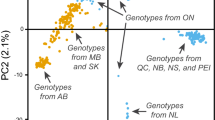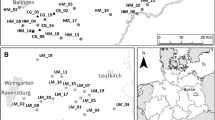Abstract
Genetic diversity was studied in wild forage species subjected to grazing along a rainfall gradient in West Niger, within the Sahel with aim of identifying adapted genotypes, which could be used to reclaim degraded land. Two legumes (Alysicarpus ovalifolius and Zornia glochidiata) and two grasses (Brachiaria xantholeuca and Cenchrus biflorus) were selected to relate phenotypic adaptation to genetic diversity in response to grazing and rainfall. Populations of each species were sampled from both heavily grazed and ungrazed sites along a rainfall gradient, approximating 200 mm yr−1 to 800 mm yr−1 rainfall isohyets. The adaptative phenotypic expressions to aridity and grazing of the populations from each of the species were characterised by morphological measures performed on the plants sampled in the field. These analyses were then compared with the results from genetic analyses using the PCR-based techniques of amplified fragment length polymorphism (AFLP) and random amplified polymorphic DNA (RAPD). Analyses of molecular data using cluster analysis (UPGMA), principal co-ordinates analysis (PCO), Mantel tests and an Analysis of Molecular Variance (AMOVA), revealed genotypic distinction between populations subjected to both differing aridity and grazing. The majority of the total genotypic variation sampled in all species occurred among individuals within a population. The significant morphological differentiation found among populations subjected to varying grazing and aridity stresses, determined through linear regression analyses, did not correlate significantly with the genotypic differentiation, as revealed by Mantel tests. The results suggest that grazing does not cause a loss of genetic diversity in the wild forage species studied, although with increasing aridity the impact of grazing on the genetic diversity of populations may increase.
Similar content being viewed by others
References
Breman H, Cissé M (1977) Dynamics of sahelian pastures in relation to drought and grazing. Oecologia 28:301–315
Coughenour MB (1985) Graminoid response to grazing by large herbivores: adaptations, exaptations, and interacting processes. Ann Mo Botanic Gardens 72:825–863
Doyle JJ, Doyle JL (1987) A rapid DNA isolation procedure for small quantities of fresh leaf material. Phytochemical Bulletin 19:11–15
Escaravage N, Questiau S, Pornon A, et al. (1998) Clonal diversity in a Rhododendron ferrugineum L. Ericaceae population inferred from AFLP markers. Mol Ecol 7:975–982
Excoffier L, Smouse PE, Quattro JM (1992) Analysis of molecular variance inferred from metric distances among DNA haplotypes: application to human mitochondrial DNA restriction data. Genetics 131:479–491
Grouzis M (1988) Structure, productivité et dynamique des systèmes écologiques sahéliens Mare d'Oursi, Burkina Faso. PhD thesis, ORSTOM, Paris, France
Gunter LE, Tuskan GA, Wullschleger SD (1996) Diversity among populations of switchgrass based on RAPD markers. Crop Sci 36:1017–1022
Heaton HJ, Whitkus R, Gómez-Pompa A (1999) Extreme ecological and phenotypic differences in the tropical tree chicozapote Manilkara zapota L. P. Royen are not matched by genetic divergence: a random amplified polymorphic DNA RAPD analysis. Mol Ecol 8:627–632
Hiernaux P (1996) The crisis of Sahelian pastoralism: ecological or economic? ODI Pastoral Development Network, Paper 39a
Hiernaux P (1998) Effects of grazing on plant species composition and spatial distribution in rangelands of the Sahel. Plant Ecol 138:191–202
Hiernaux P, Diarra L, de Leeuw PN (1994) Modelling tillering of annual grasses as a function of plant density: application to sahelian rangelands productivity and dynamics. Agric Syst 46:121–139
Hiernaux P, Turner MD (1996) Variation in growing conditions and the effect of clipping on nutrient uptake and production of sahelian annual rangelands. J Appl Ecol 33:387–399
Huff DR, Peakall R, Smouse PE (1993) RAPD variation within and among natural populations of outcrossing buffalograss [Buchloë dactyloides Nutt. Engelm.]. Theor Appl Genet 86:927–934
IACR (1995) Genstat 5 release 3.2 PC/windows 95. Lawes Agricultural Trust, Rothamsted Experimental Station
Jaccard P (1908) Nouvelles recherches sur la distribution florale. Bulletin de la Societé Vaudoise des Sci Naturelles 44:223–270
Kimura M (1983) The Neutral Theory of Molecular Evolution. Cambridge University Press, Cambridge, UK
Kölliker R, Stadelmann FJ, Reidy B, Nösberger J (1999) Genetic variability of forage grass cultivars: a comparison of Festuca pratensis Huds., Lolium perenne L., and Dactylis glomerata L. Euphytica. 106:261–270
Kuβsserow H (1997) Patterns of genetic diversity in wild forage species and in situ conservation in the Sahel. GTZ Report. Project No: 91.7860.901.165
Lance GN, Williams WT (1967) A general theory of classificatory sorting strategies 1. Hierarchical systems. Comput J 9:373–380
Li Y, Jia J, Wang Y, Wu S (1998) Intraspecific and interspecific variation in Setaria revealed by RAPD analysis. Genet Resour Crop Evol 45:279–285
Li YC, Fahima T, Beiles A, Korol AB, Nevo E (1999) Microclimatic stress and adaptive DNA differentiation in wild emmer wheat. Triticum dicoccoides Theoret Appl Genet 98:873–883
Li YC, Röder MS, Fahima T et al. (2000) Natural selection causing microsatellite divergence in wild emmer wheat at the ecologically variable microsite at Ammiad, Israel. Theoret Appl Genet 100:985–999
Li YC, Krugman T, Fahima T (2001) Spatiotemporal allozyme divergence caused by aridity stress in a natural population of wild wheat, Triticum dicoccoides, at the Ammiad microsite, Israel. Theoret Appl Genet 102:853–864
Mantel NA (1967) The detection of disease clustering and a generalised regression approach. Cancer Res 27:209–220
Milchunas DG, Varnamkhasti AS, Lauenroth WK, Goetz H (1995) Forage quality in relation to long-term grazing history, current-year defoliation, and water resource. Oecologia 101:366–374
Nei M, Li W-H (1979) Mathematical model for studying genetic variation in terms of restriction endonucleases. Proceedings of the National Acad Sci USA 76:5269–5273
Nevo E (1988) Genetic diversity in nature: patterns and theory. Evol Biol 23:217–246
O'Hanlon PC, Peakall R, Briese DT (1999) Amplified fragment length polymorphism AFLP reveals introgression in weedy Onopordum thistles: hybridisation and invasion. Mol Ecol 8:1239–1246
Owuor ED, Fahima T, Beiles A (1997) Population genetic response to microsite ecological stress in wild barley. Hordeum spontaneum Mol Ecol 6:1177–1187
Pejic I, Ajmone-Marsan P, Morgante M et al. (1998) Comparative analysis of genetic similarity among maize inbred lines detected by RFLPs, RAPDs, SSRs, and AFLPs. Theoret Appl Genet 97:1248–1255
Rogers SO, Bendich AJ (1985) Extraction of DNA from milligram amounts of fresh, herbarium and mummified plant tissues. Plant Mol Biol 5:69–76
Rohlf FJ (1993) NTSYS-pc: Numerical Taxonomy and Multivariate Analysis System, version 1.80. Exeter Software, New York, USA
Saghai-Maroof MA, Soliman KM, Jorgensen RA, Allard RW (1984) Ribosomal DNA spacer-length polymorphisms in barley: mendelian inheritance, chromosomal location, and population dynamics. Proc National Academy Sci USA 81:8014–8018
Schneider S, Roessli D, Excofier L (2000) Arlequin: a software for population genetics data analysis. Ver 2.000. Genetics and niometry Lab, Dept. of Anthropology, University of Geneva
Semagn K, Bjornstad AQ, Stedje B, Bekele E (2000) Comparison of multivariate methods for the analysis of genetic resources and adaptation in Phytolacca dodecandra using RAPD. Theoret Appl Genet 101:1145–1154
Sharma SK, Knox MR, Ellis THN (1996) AFLP analysis of the diversity and phylogeny of Lens and its comparison with RAPD analysis. Theoret Appl Genet 93:751–758
Sivakumar MVK, Konate M, Virmani SM (1984) Agroclimatology of West Africa: Mali. Information Bulletin n 19, ICRISAT. Patancheru, Andhra Pradesh, India
Sivakumar MVK, Maidoukia A, Stern RD (1993) Agroclimatology of West Africa: Niger. Second Edition. Information Bulletin n 5, ICRISAT. Patancheru, Andhra Pradesh, India
Sneath PHA, Sokal RR (1973) Numerical Taxonomy: The Principles and practise of Numerical Classification. Freeman, San Fransico, USA
Snrech S (1994) Pour préparer l'avenir de l'Afrique de l'Ouest: une visionà l'horizon 2020. OECD. Club du Sahel, Paris, France
Sokal RR, Michener CD (1958) A statistical method for evaluating systematic relationships. University of Kansas Scientific Bulletin 38:1409–1438
Tilman D, El Haddi A (1992) Drought and biodiversity in Grasslands. Oecologia 89:257–264
Tuomi J, Nilsson P, Astrom M (1994) Plant compensatory response: bud dormancy as an adaptation to herbivory. Ecology 75:1429–1436
Venable DL, Dyreson E, Piñero D, Becerra JX (1998) Seed morphometrics and adaptive geographic differentiation. Evolution 52:344–354
Volesky JD (1994) Tiller defoliation patterns under frontal, continuous, and rotation grazing. J Range Management 47:215–219
Vos P, Hogers R, Bleeker M et al. (1995) AFLP: A new technique for DNA fingerprinting. Nucleic Acids Res 23:4407–4414
Weising K, Nybom H, Wolff K, Meyer W (1995) DNA Fingerprinting in Plants and Fungi. CRC Press, London, UK
Williams JGK, Kubelik AR, Livak KJ et al. (1990) DNA polymorphisms amplified by arbitrary primers are useful as genetic markers. Nucleic Acids Res 18:6531–6535
Author information
Authors and Affiliations
Corresponding author
Additional information
R. Jamnadass and A. Muchugi Equal contribution to this work by both authors.
Rights and permissions
About this article
Cite this article
Jamnadass, R., Mace, E.S., Hiernaux, P. et al. Population genetic responses of wild forage species to grazing along a rainfall gradient in the Sahel: A study combining phenotypic and molecular analyses. Euphytica 151, 431–445 (2006). https://doi.org/10.1007/s10681-006-9175-7
Received:
Accepted:
Published:
Issue Date:
DOI: https://doi.org/10.1007/s10681-006-9175-7




